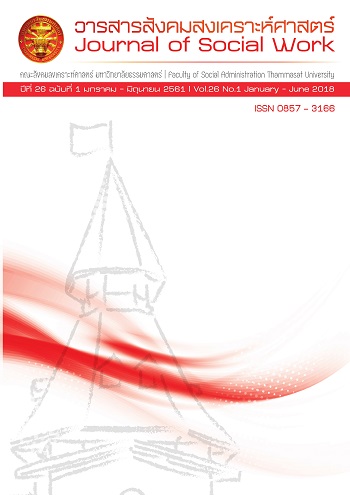The development of an Interactive e-book to Support Reading Skills of Upper Elementary School Students with Dyslexia
Keywords:
E-Book, Dyslexia, Elementary SchoolAbstract
The purposes of this study were 1) to develop an interactive e-book to support reading skills of upper elementary school students with dyslexia. 2) to compare the students’ reading achievement before and after using the interactive e-book 3) to investigate the students’ satisfaction towards the interactive e-book.
The participants were 10 upper elementary school students with dyslexia from Kamphang Saen kindergarten school, Nakhon Prathom. The participants were selected by purposive method. The research instruments were the e-book, pre-reading test, post-reading test, and semi-structured interview guide.
The results of the study revealed that
1) The format of an interactive e-book to support reading skills of upper elementary school students with dyslexia consisted of 2 main parts: 1. The structure of e-book consisted of 3 sections: front section, main section and back section; 2.Supporting tools for dyslexia consisted of tools for changing font type, font size, font and background color, text reading aloud, and the explanation of difficult word meaning.
2) The students’ reading achievement after using the e-book was significantly higher than the reading achievement before using the e-book at the level of 0.05
3) The students’ satisfaction in studying with the e-book was at the highest level.
References
ชนากานต์ สุวรรณทรัพย์. (2556). การพัฒนารูปแบบหนังสืออิเล็กทรอนิกส์สำหรับการเรียนกลุ่มสาระการเรียนรู้วิทยาศาสตร์ระดับชั้นมัธยมศึกษาตอนต้น. (ปริญญานิพนธ์การศึกษาดุษฎีบัณฑิต) มหาวิทยาลัยศรีนครินทรวิโรฒ, กรุงเทพฯ.
ไพฑูรย์ ศรีฟ้า (2551). E-Book หนังสือพูดได้. กรุงเทพมหานคร: ฐานบุ๊คส์.
สำนักงานคณะกรรมการการศึกษาขั้นพื้นฐาน. (2555). ความรู้พื้นฐานและแนวทางพัฒนานักเรียนที่มีความบกพร่องทางการเรียนรู้. สืบค้น 5 มิถุนายน 2559, จาก http:// 182.93.222.52/promote/57000001/files/201211121123051gcAM94.pdf
Ash, K. (2010). Schools test e-readers with dyslexic students. Education Week, 4(1), 22- 24. Retrieved November 11, 2016 from http://www.edweek. org/dd/articles/2010/10/20/01dyslexia.h04.html?tkn=NRMFGHakK7fOPdgXGvsqBZSEsdBtCSbrpKKS&print=1
Frye, S.K. (2014). The implications of interactive ebooks on comprehension. (Doctoral Dissertation) Rutgers, The State University of New Jersey. RetrievedJuly 2, 2016 from:https://rucore.libraries.rutgers.edu/rutgers-lib/42343/
Galuschka K, Ise E, Krick K, Schulte-Körne G (2014). Effectiveness of Treatment Approaches for Children and Adolescents with Reading Disabilities: A Meta-Analysis of Randomized Controlled Trials. PLoS ONE 9(2): e89900.
Kurniawan, S., & Conroy, G. V. (2007). Comparing Comprehension Speeds and Accuracy of Online Information in Students with and Without Dyslexia. IGI Global.
Mayer, R. E., & Moreno, R. (2003). Nine ways to reduce cognitive load in multimedia learning. Educational Psychologist, 38 (1). 43–52.
Rello, L., Kanvinde, G., & Baeza-Yates, R. (2012). Layout guidelines for web text and a web service to improve accessibility for dyslexics. Proceedings of the International Cross-Disciplinary Conference on Web Accessibility. NY: ACM.
Rello, L., Pielot, M., Marcos, M., & Carlini, R. (2013). Size matters (spacing not): 18 points for a dyslexic-friendly wikipedia. W4A 2013 - International Cross-Disciplinary Conference On Web Accessibility, (W4A 2013 - International Cross-Disciplinary Conference on Web Accessibility), doi:10.1145/2461121.2461125
Schiavo, G., & Buson, V. (2014). Interactive e-Books to support reading skills in dyslexia. In IBOOC2014-2nd Workshop on Interactive eBook for Children at IDC.
Downloads
Published
How to Cite
Issue
Section
License
The manuscripts published in the Social Work Journal is the copyright of the Social Work Journal, Thammasat University
Any article or opinion appeared in the Social Work Journal will solely be under the responsibility of the author The Faculty of Social Administration, Thammasat University and the editors do not need to reach in agreement or hold any responsibility.



